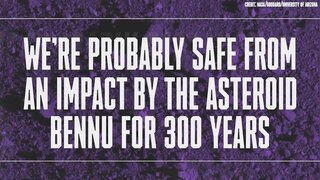Create a free profile to get unlimited access to exclusive videos, sweepstakes, and more!
NASA's First Ever Asteroid Sample Return Mission Successfully Lands in Utah
OSIRIS-REx delivered a sample from the asteroid Bennu.
From massive stones for construction and shiny gems for jewelry to rare ores for making electronics, a lot of human history has been about getting specific rocks from one place to another. Looking into the future, there’s no reason to suspect that will change. Wherever there are rocks, we’ll send someone or something to get them. That’s the premise behind the 2018 science fiction thriller Prospect, streaming now on Peacock. A space miner and his daughter travel to a faraway alien moon in search of valuable gems. But getting hold of the rocks and getting home alive is no easy task.
Just ask the real-life team behind NASA’s OSIRIS-REx mission, which traveled roughly 200 million miles to the asteroid Bennu, grabbed a sample, and turned around. The sample return capsule successfully landed in Utah’s West Desert yesterday morning, September 24, marking the end of the United States’ first asteroid sample return mission.
OSIRIS-REx Asteroid Sample Capsule Returns to Earth
Getting a small part of Bennu back to Earth has been a job nearly a decade in the making. The spacecraft launched September 8, 2016, and began the long journey to its target. Once it achieved a stable orbit around Bennu, OSIRIS-REx spent roughly two years hanging out, mapping the surface, taking the lay of the land.
RELATED: Boop! NASA Spacecraft OSIRIS-REx Pokes an Asteroid and Collects the Debris
Once it found a good landing spot, it began its descent. OSIRIS-REx stretched out an arm with a sample capture capsule attached to the end and descended to the surface for a one-sided game of space tag. Dipping into the loosely bound asteroid regolith, the spacecraft unleashed a shot of nitrogen, loosening the debris for capture. Then it backed away, returning to orbit.
The spacecraft spent about six months orbiting Bennu after the sample capture, checking out the ways the surface changed as a result of the interaction. Finally, it burned its engines on a return trajectory toward Earth. Early on the morning of September 24, OSIRIS-REx released the sample return capsule and turned back toward space. It will continue with a new name, OSIRIS-APEX, and a new mission, exploring the asteroid Apophis.
The capsule entered the atmosphere where it slowed down considerably before deploying parachutes to deliver it gently to the ground. It touched down at the Department of Defense’s Utah Test and Training Range, west of The Great Salt Lake, at 8:52 a.m. It was quickly taken by helicopter to a clean room at the range where it was kept under a constant nitrogen flow.
Bits of asteroids fall to the Earth all the time, but all of them are necessarily contaminated by the Earth by the time we get to them. The Bennu sample is an opportunity to investigate an uncontaminated piece of an asteroid, but only if we can keep all of the Earth bits away. Nitrogen is nonreactive and a constant flow of nitrogen into the capsule prevents any Earth contamination from getting inside.
RELATED: Incredible Footage of OSIRIS-REx Tagging an Asteroid
“Congratulations to the OSIRIS-REx team on a picture-perfect mission – the first American asteroid sample return in history – which will deepen our understanding of the origin of our solar system and its formation. Not to mention, Bennu is a potentially hazardous asteroid, and what we learn from the sample will help us better understand the types of asteroids that could come our way. With OSIRIS-REx, Psyche launch in a couple of weeks, DART’s one year anniversary, and Lucy’s first asteroid approach in November, Asteroid Autumn is in full swing. These missions prove once again that NASA does big things. Things that inspire us and unite us. Things that show nothing is beyond our reach when we work together,” said NASA Administrator Bill Nelson, in a statement.
As of today, Monday, September 25, the canister will be transported to a facility at NASA’s Johnson Space Center in Houston, Texas. Once there, scientists will open the canister and characterize its contents, creating an inventory of the rocks and dust from Bennu.
These rocks won’t make their way into bricks or jewelry, but they might be some of the most scientifically valuable stones we’ve ever laid eyes on. A better understanding of Bennu could help develop better Earth defense systems for planet-killing impactors. In the meantime, it could help us better understand the formation of the solar system and our place in it.
Catch Prospect starring Pedro Pascal, streaming now on Peacock!































